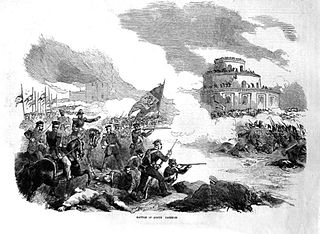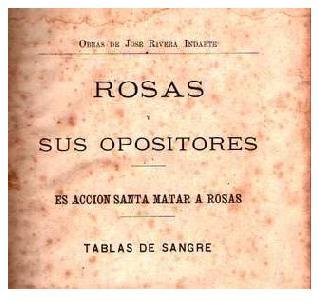
The Argentine Confederation was the last predecessor state of modern Argentina; its name is still one of the official names of the country according to the Argentine Constitution, Article 35. It was the name of the country from 1831 to 1852, when the provinces were organized as a confederation without a head of state. The governor of Buenos Aires Province managed foreign relations during this time. Under his rule, the Argentine Confederation resisted attacks by Brazil, Bolivia, Uruguay, France and the United Kingdom, as well as other Argentine factions during the Argentine Civil Wars.

Manuel Ceferino Oribe y Viana was the 2nd Constitutional president of Uruguay.

José Fructuoso Rivera y Toscana was a Uruguayan general and patriot who fought for the liberation of Banda Oriental from Brazilian rule, twice served as Uruguay's President and was one of the instigators of the long Uruguayan Civil War. He is also considered to be the founder of the Colorado Party, which ruled Uruguay without interruption from 1865 until 1958. He made a controversial decision to almost completely eliminate the native Charrúa during the 1831 Massacre of Salsipuedes.

The Battle of Caseros was fought near the town of El Palomar, Buenos Aires Province, Argentina, on 3 February 1852, between the Army of Buenos Aires commanded by Juan Manuel de Rosas and the Grand Army led by Justo José de Urquiza. The forces of Urquiza, caudillo and governor of Entre Ríos, defeated Rosas, who fled to the United Kingdom. This defeat marked a sharp division in the history of Argentina. As provisional Director of the Argentine Confederation, Urquiza sponsored the creation of the Constitution in 1853, and became the first constitutional President of Argentina in 1854.
The Treinta y Tres Orientales was a militant revolutionary group led by Juan Antonio Lavalleja and Manuel Oribe against the Empire of Brazil. Their actions culminated in the foundation of modern Uruguay. They became famous by the name of the Treinta y Tres Orientales when, in 1825, they began an insurrection for the independence of Oriental Province, a historical territory encompassing modern Uruguay and part of modern Brazilian Rio Grande do Sul State, from Brazilian control.

The Uruguayan Civil War, also known in Spanish as the Guerra Grande, was a series of armed conflicts between the leaders of Uruguayan independence. While officially the war lasted from 1839 until 1851, it was a part of armed conflicts that started in 1832 and continued until the final military defeat of the Blancos faction in 1904. Out of supporters of presidents Rivera and Oribe grew the Colorado Party and the National Party, both of which received backing and support from foreign sources, including neighboring Empire of Brazil, the Argentine Confederation, Buenos Aires Province as well as European powers, primarily the British Empire and the Kingdom of France, but also a legion of Italian volunteers including Giuseppe Garibaldi. The great diversity of nationalities among the military forces supporting the Colorado Party posed a difficulty when coming to express their struggle in terms of a "national liberation", instead the Colorado Party side put forward a rhethoric on them defending "humanity" and "civilization" against "tyranny".

Aparicio Saravia Da Rosa was a Uruguayan politician and military leader. He was a member of the Uruguayan National Party and was a revolutionary leader against the Uruguayan government.

Brazil–Uruguay relations encompass many complex relations over the span of three centuries, beginning in 1680 with the establishment of the Colónia do Sacramento, to the present day, between the Federative Republic of Brazil and the Oriental Republic of Uruguay. Brazil and Uruguay are neighbouring countries in South America, and share close political, economic and cultural ties. The singularity of the bilateral relationship between the two countries originates from a strong historical connection – marked by important events, such as the establishment of the Colónia do Sacramento in 1680, the invasion of the Banda Oriental by Brazil in 1815 and the subsequent creation of the Província Cisplatina, and Uruguay's independence from Brazil in 1828. The bilateral relationship was further defined by the Uruguayan Civil War (1839–1851) and the Paraguayan War (1864–1870).

Foreign relations between the Argentine Republic and the Oriental Republic of Uruguay, for over a century. Both countries were part of the Spanish Empire until the early 19th century.

The Platine War was fought between the Argentine Confederation and an alliance consisting of the Empire of Brazil, Uruguay, and the Argentine provinces of Entre Ríos and Corrientes. The war was part of a long-running dispute between Argentina and Brazil for influence over Uruguay and Paraguay, and hegemony over the Platine region. The conflict took place in Uruguay and northeastern Argentina, and on the Río de la Plata. Uruguay's internal troubles, including the longrunning Uruguayan Civil War, were heavily influential factors leading to the Platine War.

The French blockade of the Río de la Plata was a two-year-long naval blockade imposed by France on the Argentine Confederation ruled by Juan Manuel de Rosas. It closed Buenos Aires to naval commerce. It was imposed in 1838 to support the Peru–Bolivian Confederation in the War of the Confederation, but continued after the end of the war. France did not land ground forces, but instead took advantage of the Uruguayan Civil War and the Argentine Civil Wars, supporting Fructuoso Rivera and Juan Lavalle against Manuel Oribe and Rosas.

Pascual Echagüe, was an Argentine soldier and politician. He served as Governor of Entre Ríos and Santa Fe provinces and Minister of War and Navy during the governments of Urquiza and Derqui. He participated in the Argentine Civil Wars and the Uruguayan Civil War.
Montevideo, or the new Troy is an 1850 novel by Alexandre Dumas. It is a historical novel about the Uruguayan Civil War, where the Uruguayan presidents Manuel Oribe and Fructuoso Rivera disputed the rule of the country. The name sets a parallelism with the Trojan War, as Oribe kept Montevideo, capital of Uruguay, under siege for many years.

The Argentine Civil Wars were a series of internecine wars that took place in Argentina from 1814 to 1876. These conflicts were separate from the Argentine War of Independence, though they first arose during this period.

Ángel Pacheco, was an Argentine military officer trained by José de San Martín who later became one of the top commanders in the Confederacy during the dictatorship of Juan Manuel de Rosas. He never lost a battle under his command.

Blood tables: it is a holy action to kill Rosas is an 1843 Argentine libelle written by José Rivera Indarte against the governor of Buenos Aires, Juan Manuel de Rosas. It details 465 purported crimes committed by Rosas or the Popular Restoring Society; later editions increased the number by 22,560. The book was used as a primary source by the early historiography of Juan Manuel de Rosas; modern historians consider its figures to be inflated.

The Battle of Sarandí was fought on 12 October 1825, in the vicinity of the Arroyo Sarandí in Uruguay, between troops of the Banda Oriental and the Empire of Brazil. It resulted in a decisive victory for the Orientals.
Feliciano Canaveris (1813–1843) was an Argentine military officer, who participated in the Argentine and Uruguayan Civil War. He was separated from the Confederate Army in 1835, and forced to go into exile in Montevideo in 1839, where he joined the ranks of the armies of Juan Lavalle and Fructuoso Rivera in the Banda Oriental.
Ramón de Amaya was an Argentine-Uruguayan military man and politician, who fought against the English during the British invasions of the River Plate, and who participated in the Uruguayan Civil War.

José Brito del Pino (1797–1877) was a Uruguayan soldier and patriot, who participated in the Argentine War of Independence, the Cisplatine War and the Uruguayan Civil War. He was one of the founding members of the Partido Nacional Uruguayo.
















